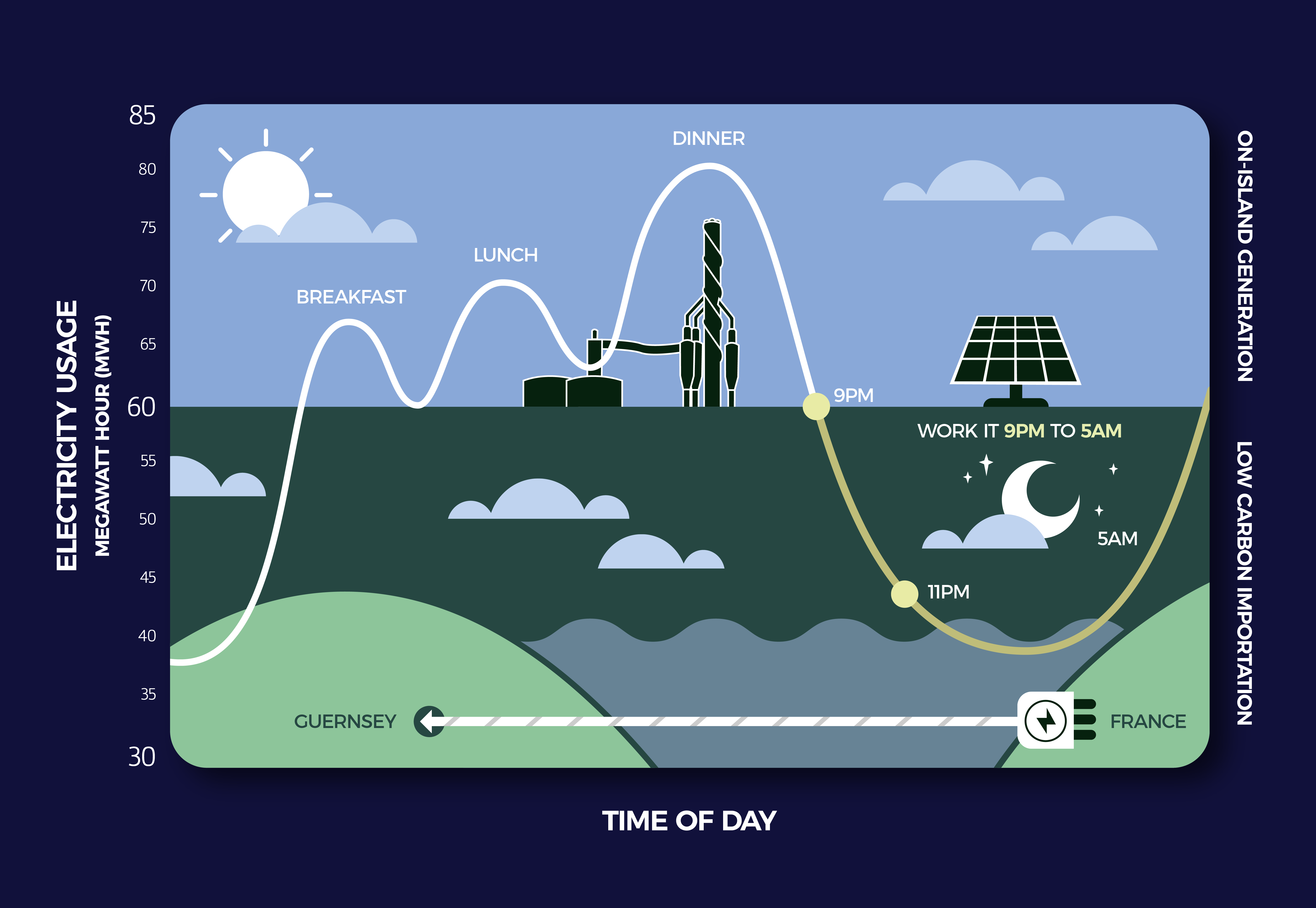With increased pressure for ‘Environmental’ reporting to become more transparent between businesses and stakeholders, how can an unseen force running a business play such an important role?
WHERE OUR ELECTRICITY COMES FROM
In Guernsey, we import around 90% of our electricity annually from low-carbon sources in Europe. This provides security of supply which helps our island maximise the bridge to tomorrow’s technology and supports the growth of more local renewable generation.
The remaining demand is topped up using on-island solar an fuels at the Vale power station.
A typical work week places a much higher demand on the island’s network assets than any other time, mainly due to commercial and business use. While we work, we use a lot of electricity, and this has an impact on both personal and business carbon footprints.

ACCESSING CARBON REPORTING FOR ESG
See information for your carbon reporting by visiting our dedicated page.
When we talk about the carbon intensity of electricity, we refer to the number
of grams of carbon dioxide equivalent (CO2e) that it takes to generate one unit of electricity per hour (kW/hour).
Our Greenhouse Gas (GHG) data collection allows us to disclose GHG emissions involved in the company activities directly under Guernsey Electricity’s control (excluding supplier and contractor emissions). We can then breakdown our carbon reporting into:
-
Direct emissions, such as the combustion of fuel for electricity generation at the power station and company vehicles.
-
Indirect emissions, such as importing electricity from the European grid.
We use Lifecycle Intensity to understand the carbon impact of electricity distributed to all homes and businesses, calculating the emissions associated at each lifecycle stage, including:
-
Materials used for plant construction
-
Embodied carbon for each type of generation technology, including on-island generation and imported electricity
-
On-site operations
-
Supply chain of fuel
-
Transmission and distribution losses
What is CO2e? CO2e summarises the overall contribution to global warming. It takes into account carbon dioxide alongside other greenhouse gas emissions, such as methane, nitrous oxide and fluorinated gases.
HOW CAN A BUSINESS INCREASE EFFICIENCY THROUGH ELECTRICITY USAGE?
As of 31 December 2022, Guernsey’s Lifecycle carbon intensity was 86g CO2e/ kWh. This figure is the sum of many complex parts and provides a base to support ESG reporting.
For example, imagine a business reports using 50,000 kWh of electricity a year.
86g CO2e x 50,000kWh = 4.3tonnes (4,300,000g) CO2e produced annually from electricity usage.
Updated emissions information including 2023 figures is due to be published in the spring.
With such large figures, every small action taken to reduce electricity usage at work makes a significant difference.
Peak ‘electricity’ demand occurs around 8am, 2pm and 6pm during a typical workweek. In winter months and particularly when it’s colder and darker outside, fossil-fuel generation at the power station is needed to meet islander’s increased demand for electricity.
There are many ways to reduce electricity usage – from always switching off lights and equipment when finished, to installing energy-efficient building designs, to using Energy Management Systems (EMS).

The main driver of workplace sustainability is choice of actions, and electricity can be an easy place to start.
For example, employee engagement and training may help establish mindful energy conservation as ‘BAU’ within the workplace, delivering efficiency, cost savings and environmental benefits. In Guernsey, moving electricity usage outside of peak times can directly reduce fossil fuel generation and their associated carbon emissions.
Even though you might not think it matters as you’re at work, reducing your energy consumption has significant positive implications – just as it does when you’re at home.

WHAT CAN YOU DO AT HOME?
The cleanest and least expensive time to run electrical appliances is between 11pm and 5am, as this is when you don’t need to rely on fossil-fuels to power your life - even on the coldest winter night.
Wherever possible, set the timers to start after 11pm for a significant reduction to your carbon footprint:
- Washing machines
- Dishwashers
- Tumble dryers
- Hot water cylinders
- Electric Vehicle chargers.
The illustration below shows the three demand peaks we can all help to reduce.













